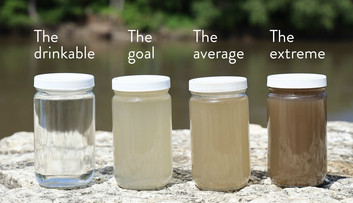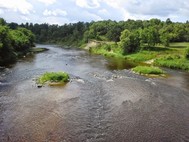
Changes in water and land management are needed across the Minnesota River Basin for the state’s namesake river to improve in water quality, as well as streams and lakes throughout the 10 million acres of the basin, according to four studies by the Minnesota Pollution Control Agency (MPCA) and local partners.
The studies, funded by the Legacy Amendment, determined the Total Maximum Daily Load (TMDL) or the maximum amount of a pollutant that a water body can accept and still meet water quality standards. The standards are designed to make sure waters are fishable and swimmable.
One study concerns the major portion of the Minnesota River, focusing on Total Suspended Solids or sediment and other particles that cloud the water. The study calls for decreasing sediment in the river by 50 percent. Too much water draining at too fast a rate erodes soil from land as well as streambanks, bluffs and ravines, muddying the water. The muddy water then makes it hard for fish and other aquatic species to breathe, find food and reproduce. The sediment is also filling in the Lower Minnesota River and even Lake Pepin downstream at a much faster rate than before European settlement – and intensive farming – of the basin.
In addition to the main Minnesota River, TMDL studies for the Lower Minnesota, Minnesota River-Mankato and Watonwan river watersheds will be open for comment. Altogether, these three studies look at dozens of river segments impaired by bacteria, sediment, nutrients and/or chloride as well as 50 lakes with nutrient levels high enough to cause algae. The MPCA and partners have prepared Watershed Restoration and Protection Strategies (WRAPS) for the three watersheds, also open for comment.
To learn more about the studies:
To provide feedback:
- Comments must be in writing and are due by 4:30 p.m., Sept. 20.
- Use the line comment form at www.pca.state.mn.us/help-us-help-our-water-comment.
- Written comments must include a statement of your interest in the report and the action you wish the MPCA to take, including specific references to sections of the draft report you believe should be changed and the reasons for making those changes.
|
The MPCA has posted the Draft: Lake Pepin Watershed Phosphorus TMDL Report on its website for informal review and comment. Interested parties may submit comments through Sept. 20. They may also request a meeting by phone or in person to learn more about the draft TMDL. Send comments, or meeting requests, to Justin Watkins, watershed supervisor, at justin.watkins@state.mn.us or 507-206-2621.
The formal public notice will follow later this year.
How do we find a path to cleaner water and better habitat while maintaining agricultural profitability? What will it cost and how can we pay for it? Find answers at the AgroEcology Summit Aug. 16-17 at Willow Lake Farm near Windom. In conjunction with the Science Museum of Minnesota, experts will present tangible examples of policies that could improve water quality and habitat by creating incentivized markets for products derived from novel, perennial cropping systems.
On Friday, Aug. 16, the Willow Lake Farm, 93532 520th Ave., Windom, will welcome visitors for a weekend of conversations, swimming, camping, field trips, homegrown food and live music. Local, authentic Ethiopian meals, and festive barn dances with live music cap off each evening. The event is open to all, and there is no admission fee.
Why is this important?
Recent increases in harmful blue-green algal blooms in many lakes and the steep decline in Monarch butterflies are signatures of the trends in agricultural intensification and loss of perennial lands/crops.
Measurable improvements to water quality and habitat hinge on reshaping the discussion about affordable ways to implement perennial vegetation/crops. People must think about products such as electricity and fuel (kilowatts) and food (calories) as markets that can be developed and modified to use large acreages of perennial feedstocks. This will create a landscape that benefits both water quality and habitat.

The Mississippi River – Grand Rapids watershed in northern Minnesota has very good overall water quality, but forest protection is critical to preserving it, according to new draft reports released by the MPCA.
This watershed drains more than 1.3 million acres of land from the Laurentian Continental divide to the Mississippi River near Palisade. It contains almost 2,000 miles of streams and 625 lakes greater than 10 acres. It includes the cities of Grand Rapids, Nashwauk, Coleraine, Hill City, McGregor, Remer and Cromwell. It is also home to unique plant and animal species such as wild rice and trout, along with a wealth of healthy forests.
The MPCA assessed whether 73 streams in the watershed meet the state water quality standards for aquatic life and recreation such as fish and swimming. Only six streams had high levels of bacteria that can make water unsafe for recreation and 17 did not meet expectations for fish and bugs. In addition, the MPCA studied dozens of lakes and found most meet the standards.
“This watershed is an important source of drinking water for millions of people downstream,” said Katrina Kessler, MPCA’s assistant commissioner of water. “This region has an abundance of beautiful lakes that make it an important recreational destination.”
The MPCA identified several stressors to aquatic life in the watershed, including increased erosion, degradation of habitat by sedimentation and historical ditching, which causes streams to suffer from low levels of dissolved oxygen. The most likely causes of bacteria impairments in the watershed are wildlife and livestock feces, along with failing septic systems.
Best management practices include improved septic system maintenance, and addressing shoreline erosion and stormwater runoff. Key watershed-wide strategies that will improve the quality of impaired and unimpaired lakes and streams include protecting forested lands, decommissioning non-functioning ditches, and updating and enforcing shoreland ordinances. Protecting forested lands provides significant benefits to water quality.
The MPCA is seeking public comments on the draft reports through Aug. 14. The first report, known as a Total Maximum Daily Load, establishes the amount of each pollutant that a water body can accept and still meet water quality standards. The TMDL study addressed phosphorus and bacteria impairments in seven lakes and six streams.
The second report, a Watershed Restoration and Protection Strategy (WRAPS), is required by the state Clean Water Legacy Act and uses the TMDL, monitoring results, and other information to develop strategies for addressing all pollution sources in the watershed. The objective of the WRAPS process is to develop strategies that not only restore impaired waters but also protect the unimpaired waters from degradation. The WRAPS report showed that the watershed is quite healthy and protection strategies will help keep it that way.
The draft reports are available on the MPCA’s Mississippi River-Grand Rapids watershed webpage. Submit comments, which must be in writing, to Anna Bosch, MPCA, 7678 College Road, Baxter, MN, 56425, or by email to anna.bosch@state.mn.us by 4:30 p.m. on Aug. 14. For more information, contact Bosch at 218-316-3929, or toll-free at 800-657-3864.
Written comments must include a statement of the respondent’s interest in the report, and the requested action required by the MPCA, including specific changes to sections of the draft report and the reasons for making those changes.
|

A number of factors are hurting fish and aquatic insects, as well as recreation, in several segments of the Red Lake River and its tributaries in northwest Minnesota, according to new draft reports released by the MPCA.
The Red Lake River begins at the outlet of Lower Red Lake and flows through the cities of Thief River Falls and Red Lake Falls on the way to its confluence with the Red River of the North in East Grand Forks.
Bacteria is one factor in six segments, meaning the water could be unsafe at times for recreation. The MPCA used DNA testing to identify likely sources of the E. coli bacteria, which are found in fecal matter. The tests showed likely sources of E. coli contamination likely came from feedlots and cattle in streams, faulty septic systems, and birds nesting under bridges.
“As Minnesotans head to our rivers and lakes for swimming and fishing, we need to take the threat of E. coli bacteria in our water seriously,” said Katrina Kessler, MPCA’s assistant commissioner of water. “While our farmers and homeowners continue to make progress fixing old septics and limiting cattle access to streams, birds and other wildlife also add to our E. coli problem.”
In addition, six stream segments were impaired for aquatic life due to excessive levels of total suspended solids. MPCA and local staff also investigated reasons for poor aquatic life populations and low dissolved oxygen levels found in 11 segments of tributaries to the Red Lake River. Scientists found lack of habitat due to periods of low-flow conditions to be a primary reason.
The MPCA is asking for public comments on the two reports that recommend ways to restore and protect streams for fish, aquatic insects and recreation throughout the Red Lake River watershed. Members of the public can submit comments on the reports through Aug. 13.
The Red Lake River Watershed Total Maximum Daily Load (TMDL) report identified impaired water bodies, pollution sources/levels, and ways to return water quality to an acceptable level. The Red Lake River Watershed Restoration and Protection Strategy (WRAPS) report additionally identified waters in need of protection and recommendations to protect those waters.
While landowners and water managers in the watershed have long been engaged in good land stewardship practices and have completed many water quality improvement projects, the reports recommend additional efforts to restore impaired waters and protect unimpaired areas important for recreation and aquatic life.
Submit comments, which must be in writing, to Denise Oakes, 714 Lake Ave., Suite 220, Detroit Lakes, MN 56501; or by email, denise.oakes@state.mn.us. If you have questions, she can be reached by phone, 218-846-8119. More information is also available from Corey Hanson, Red Lake Watershed District: 218-681-5800, corey.hanson@redlakewatershed.org.
Written comments must include a statement of the respondent’s interest in the report, and the requested action required by the MPCA, including specific references to sections of the draft report that should be changed and the reasons for making those changes.
|
Itasca Waters is hosting the “We Are Water MN” exhibit at the Reif Performing Arts Center in Grand Rapids from Aug. 4 – Sept. 16. The exhibit and events are designed to build awareness of the ways water shapes the history, culture, and identity of those who live in the headwaters, and to invite people to enjoy and protect the many lakes and rivers in Itasca County.
“We Are Water MN” is a popular statewide traveling exhibit and community engagement project that invites visitors to reflect on the experiences of local people and come to a deeper understanding of what taking care of water means to people. Science and history are also included via this 1,000-square foot, hands-on exhibit created by the Minnesota Humanities Center, MPCA, Minnesota Historical Society, and Departments of Health, Agriculture and Natural Resources.
Visiting the exhibit
“We Are Water MN” is open Aug. 4 – Sept. 16, at the Reif Performing Arts Center in Grand Rapids (720 NW Conifer Drive, Grand Rapids, MN 55744). Hours are Monday – Friday, 10 a.m. – 4 p.m.
As a part of the exhibit, Itasca Waters and partners will offer an opening celebration on Friday, Aug. 2, from 4:30 to 7 p.m. at the Reif Center.
For information, visit the MPCA website.
|